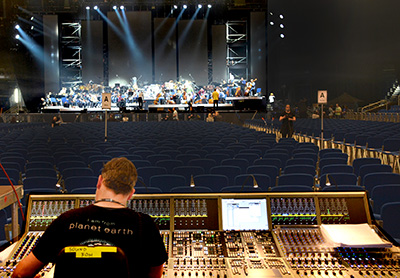The World of Hans Zimmer – A Symphonic Celebration has began a concert tour of Germany – although the film composer’s himself will not be appearing. Instead, the show presents his soundtracks for blockbuster productions, which he has rearranged for orchestral performance.
 Zimmer chose Germany for this world premère, and equipment from the Berlin-based manufacturer Stage Tec for the tour including a 48-fader Aurus platinum mixing desk for FOH position and a Nexus system with six Base Devices – three for the FOH side rack and three for I/O.
Zimmer chose Germany for this world premère, and equipment from the Berlin-based manufacturer Stage Tec for the tour including a 48-fader Aurus platinum mixing desk for FOH position and a Nexus system with six Base Devices – three for the FOH side rack and three for I/O.
Two Nexus Star routers supplement the network – one for Aurus processing at the FOH position, the other for monitoring with a Madi connection and for the remaining three Nexus Base Devices. A virtual console is also deployed to configure the spectral Delta Stereophony of the front fill. Virtual console means that the Aurus can switch to a second DSP core during set-up. Later, the virtual console is accessed via an external PC.
The challenge in this production is the large number of channels and buses needed for the orchestra, choir and a 15-piece band. In addition, the frequent instrument changes make it very demanding. Percussion instruments always play an important role in Zimmer’s music, as illustrated by 50 percussion channels alone. In total, up to 250 mixing channels on 128 buses are used.
The virtual console has another 193 inputs in a matrix on eight outputs for the near fills. To accommodate this large number of audio channels the Nexus network is equipped with seven RMDQ high performance DSP units. Twenty-three XMIC microphone boards, each with eight channels, are available for the numerous microphone configurations.
The new VCA group hierarchy feature was developed for Aurus especially for this project, which the lead Tonmeister Carsten Kümmel needs for this production: ‘I use the new VCA hierarchy to handle the large number of channels,’ he says. ‘I can assign a channel to several groups and create groupings, resulting in a VCA pyramid. In this project we are no longer mixing individual channels but mixing via VCAs.
‘I’m using scene automation for the first time, and I create snapshots before the show, which I have triggered by an external time code. We have a time code show here, so I’ve always triggered all soloists and effects by time code. That means I don’t have to think about everything during the show but can concentrate on the music.’
More: www.stagetec.com














